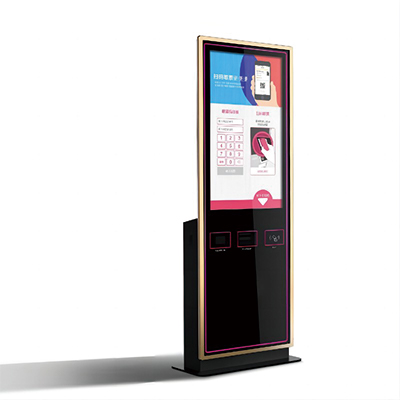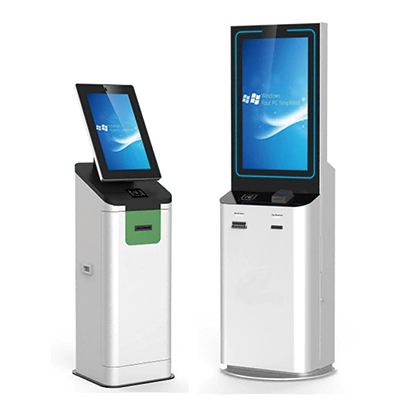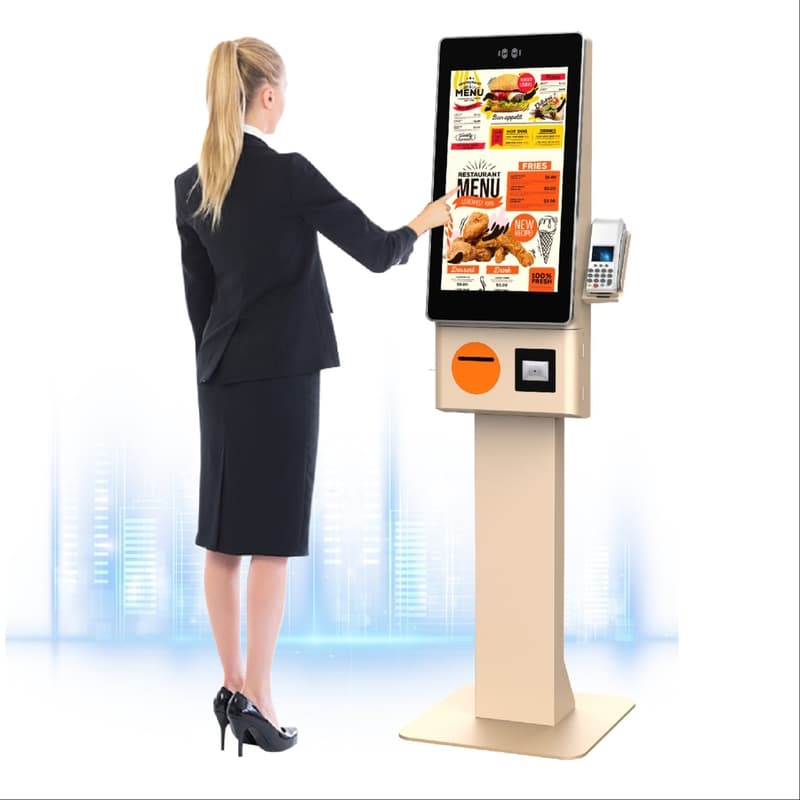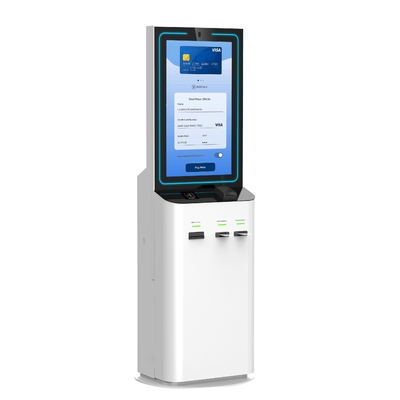Below is a video of kiosk touchscreen, watch it carefully to learn more!
Be sure to watch the video above to explore more about the detailed aspects of kiosk touchscreens, including screen sizes, brightness levels, and installation techniques. This video provides valuable insights into how these factors enhance the user experience and ensure optimal performance in different settings. Don't miss out on this comprehensive guide to choosing the right touchscreen for your kiosk needs!
| Specification | Details |
|---|---|
| Screen Size | Available in various sizes, typically ranging from 10" to 55" or larger. |
| Touch Technology | Capacitive, Resistive, Infrared (IR), or Surface Acoustic Wave (SAW). |
| Resolution | Common resolutions include HD (1280x720), Full HD (1920x1080), 4K (3840x2160). |
| Aspect Ratio | Standard ratios are 16:9 (widescreen) and 4:3. |
| Brightness | Ranges from 300 nits to 1500 nits, depending on indoor or outdoor use. |
| Touch Points | Single-touch or multi-touch (up to 10 or more simultaneous touch points). |
| Glass Type | Tempered, Anti-glare, or Anti-reflective glass for durability and visibility. |
| Durability | Scratch-resistant and vandal-proof options available, often rated IK08 or IK10. |
| Response Time | Typically 5ms to 20ms for quick user interaction. |
| Operating Temperature | Ranges from -20°C to 60°C, suitable for various environments. |
| Connectivity | USB, HDMI, VGA, or Ethernet options for integration with other systems. |
| Mounting Options | VESA mount, flush mount, or custom mounting solutions based on installation needs. |
| Power Supply | Usually 12V DC, with options for PoE (Power over Ethernet) in some models. |
| Certification | CE, FCC, RoHS, and IP65/IP66 ratings for outdoor models. |
Capacitive Touchscreen: Utilizes the electrical properties of the human body to detect touch, offering high sensitivity and multi-touch capabilities.
Resistive Touchscreen: Consists of multiple layers that respond to pressure, allowing for input via fingers, gloves, or styluses.
Infrared (IR) Touchscreen: Uses an invisible grid of infrared light beams across the screen surface to detect touch points.
Surface Acoustic Wave (SAW) Touchscreen: Employs ultrasonic waves that pass over the screen; touch is detected when these waves are absorbed.
Optical Touchscreen: Utilizes cameras placed around the edges of the screen to detect touch by interpreting interruptions in the light paths.
Projected Capacitive Touchscreen (PCAP): An advanced form of capacitive touch, offering even greater sensitivity and the ability to detect touch through protective glass layers.

Common kiosk touchscreen sizes and resolutions:
| Screen Size | Common Resolutions |
|---|---|
| 10" - 12" | 1024x768, 1280x800 |
| 13" - 15" | 1366x768, 1920x1080 (Full HD) |
| 17" - 19" | 1280x1024, 1440x900, 1920x1080 (Full HD) |
| 21" - 24" | 1920x1080 (Full HD), 2560x1440 (Quad HD) |
| 27" - 32" | 1920x1080 (Full HD), 2560x1440 (Quad HD), 4K (3840x2160) |
| 43" - 55" | 1920x1080 (Full HD), 4K (3840x2160) |
Small Screens (10" - 12"): Often used in compact kiosks for basic information or transactional tasks.
Mid-sized Screens (13" - 19"): Ideal for interactive applications, including retail and wayfinding.
Large Screens (21" - 32"): Suitable for detailed displays and interactive content, such as directories or self-service.
Extra-large Screens (43" - 55"): Commonly used in digital signage and large-format interactive kiosks.

Kiosk touchscreen brightness and visibility considerations
| Brightness (Nits) | Visibility and Application |
|---|---|
| 200 - 300 nits | Suitable for indoor environments with controlled lighting, such as retail stores and offices. |
| 400 - 500 nits | Ideal for well-lit indoor areas and semi-outdoor locations with moderate sunlight exposure. |
| 600 - 700 nits | Provides good visibility in bright indoor environments, such as atriums and areas near windows. |
| 800 - 1000+ nits | Designed for outdoor kiosks and locations with direct sunlight, ensuring clear visibility in harsh lighting conditions. |
Key Considerations:
Anti-Glare Coating: Reduces reflections and glare, improving visibility in bright environments.
Anti-Reflective Coating: Minimizes screen reflections, enhancing readability under direct light.
Sunlight Readable Technology: Combines high brightness with optical bonding to improve outdoor visibility.
Viewing Angles: Wide viewing angles ensure the screen is readable from different positions, essential for public kiosks.

Screen Size and Aspect Ratio: Choose from various screen sizes and aspect ratios to fit specific kiosk designs and user interaction needs.
Brightness Levels: Customize brightness settings to ensure optimal visibility in different environments, from indoor to outdoor applications.
Touch Technology: Select the type of touch technology (e.g., capacitive, resistive, IR) based on the intended use, user experience, and durability requirements.
Anti-Glare and Anti-Reflective Coatings: Add coatings to reduce glare and reflections, enhancing screen readability in bright conditions.
Durability Enhancements: Customize the screen with tempered glass or vandal-resistant coatings for increased durability in high-traffic or outdoor areas.
Interactive Features: Incorporate multi-touch capabilities or gesture recognition to enhance user interaction and provide a more intuitive experience.

The cost of a kiosk touchscreen varies based on size, technology, and customization. Basic models with standard features are more affordable, while advanced options with high brightness, durability, and specialized touch technologies come at a higher price. Investing in high-quality touchscreens can lead to better user experiences and reduced maintenance costs. The ROI is realized through increased efficiency, enhanced customer engagement, and the ability to handle high traffic volumes. Over time, improved functionality and reliability contribute to cost savings and revenue growth, making the investment worthwhile.

Kiosk touchscreens are widely used across various industries, providing intuitive, interactive interfaces for users. Common applications include:
Retail: Used in self-checkout kiosks and information displays, allowing customers to make purchases or find product information easily.
Healthcare: Employed in patient check-in kiosks, enabling efficient registration and reducing wait times.
Hospitality: Found in self-service check-in kiosks at hotels, providing a seamless check-in experience for guests.
Transportation: Utilized in ticketing kiosks at airports and train stations, facilitating quick and easy ticket purchases.
Entertainment: Used in cinema and movie theater kiosks for ticket purchases and selecting seats.
Food Service: Integrated into self-ordering kiosks in restaurants, allowing customers to place orders directly.
Outdoor Environments: Deployed in outdoor kiosks for informational purposes, such as wayfinding in parks or public spaces.
1. Identify Your Application Needs:Determine the primary use case (e.g., retail, healthcare, transportation). Understand the environment (indoor vs. outdoor) to select the appropriate brightness and durability. | 2. Select the Appropriate Screen Size:Choose a screen size that fits the kiosk design and meets user interaction requirements. Consider the aspect ratio and resolution needed for clear display and readability. |
3. Choose the Right Touch Technology:Decide between capacitive, resistive, or infrared touchscreens based on the desired user experience and durability. | 4. Consider Brightness and Visibility:Select the appropriate brightness level (nits) for the environment to ensure visibility. Opt for anti-glare or anti-reflective coatings if needed. |
5. Evaluate Durability Requirements:Assess if your touchscreen needs vandal-resistant features, waterproofing, or tempered glass for enhanced durability. | 6. Explore Customization Options:Consider additional customization such as multi-touch capabilities, gesture recognition, or specific interactive features. |
Choose a reputable vendor offering good customer support, installation services, and an extensive warranty to ensure a smooth purchase experience and long-term reliability.








What did our happy clients say?
The kiosk touchscreen we purchased exceeded our expectations! Its responsiveness and clarity have greatly enhanced our customer interactions, making self-service more efficient and engaging. Highly recommend for any business looking to upgrade your kiosks.
Our new kiosk touchscreens have been a game-changer. The display is sharp, and the touch response is flawless. Installation was smooth, and the durability in our high-traffic area has been impressive. We couldn't be happier with this investment.
We recently upgraded to these touchscreens for our self-ordering kiosks, and the difference is night and day. The anti-glare feature is fantastic, even in bright lighting. Our customers love the intuitive experience. Excellent quality and value!
The kiosk touchscreen we installed in our outdoor setup performs remarkably well. It's highly responsive, even in harsh weather conditions, and the brightness is perfect for all times of day. A solid choice for any business needing reliability and durability.